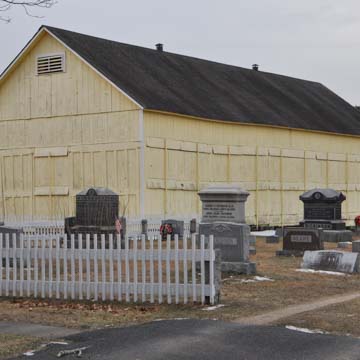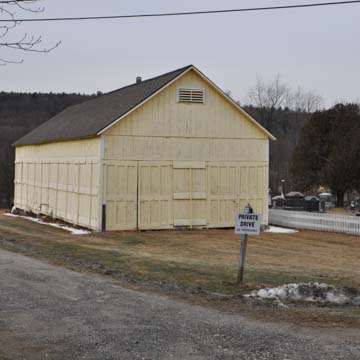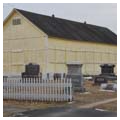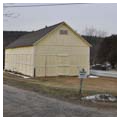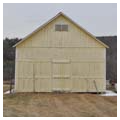This long, simple tobacco shed (alternately called a tobacco barn) in the center of Whately, a rural town in the Connecticut River Valley, facilitated a single agricultural procedure: the drying and curing of broadleaf and shade-grown tobacco for use in cigar wrappers and binding. This building’s unassuming simplicity belies the depth of history it represents and perseveres as a rare surviving example of a once common building type in the area. From roughly the 1830s to the 1950s, tobacco cultivation occupied a central role in Whately and grew to become the dominant cash crop in a region extending from Middletown, Connecticut, to just north of Greenfield, Massachusetts. Constructed circa 1860, the Chestnut Plain Road Tobacco Shed represents a rare extant example of local craftsmanship and the development of a regional, vernacular architectural form. Through the lens of this tobacco shed, one can glimpse the development of Whately and witness the confluence of environmental conditions, economic transformations, agricultural technology, and social movements that sustained the tobacco industry in the Connecticut Valley.
Whately lies in a region with a climate and soil composition well-suited for tobacco growing. The Connecticut River, which borders Whately on the east, widens here through a valley of gently rolling hills interspersed with flat meadows known locally as “intervales.” In this same valley, retreating glaciers deposited exceptionally fertile and well-drained alluvial soil. In the nineteenth century, the intervales also benefited from a high water table and periodic flooding, which revitalized soils. (Dams along the Connecticut River have since ended seasonal flooding.)
The Connecticut Valley’s intervales and general fecundity attracted Native Americans and, in the late seventeenth and early eighteenth century, European colonists. Whately initially boasted small plantations beginning in the 1670s, and was incorporated as a town in 1771. These farmsteads grew a variety of vegetable crops for subsistence and export. Early on, tobacco formed part of Whately’s agricultural economy, with records showing that the town’s first minister grew and sold a large crop of tobacco in 1671. Of course, tobacco, a weed-like plant indigenous to North America, had long been integral to Native Americans’ religious and community-building rituals. Along the Atlantic seaboard, the crop was a crucial export for the nascent colonies. Additionally, many European colonists grew small amounts for home consumption.
In the early 1840s, farmers in Whately experimented with a new variety of tobacco called Connecticut Broadleaf. Over the next two decades, tobacco cultivation increased dramatically in Whately: from one acre sown in 1845, to 69 acres in 1855, and 303 in 1865. The Waite family, who had bought the former Morton homestead, built the Chestnut Plain Road Tobacco Shed circa 1860, during the industry’s period of greatest growth. Indeed, Whately farmers had constructed 97 tobacco sheds by 1855.
The process of planting, tending, and harvesting tobacco required backbreaking work and careful attention. After starting seeds in cold frames and transplanting the small plants to the field, farmers had to pinch leaves to incite growth, hoe to remove weeds, and pull out suckers that diverted nutrients from the main growth. Moreover, tobacco plants were especially susceptible to various diseases and hail damage. Market fluctuations and periodic overproduction combined with natural vicissitudes rendered tobacco a fickle crop whose profit margin alternated widely over the course of the nineteenth and into the twentieth century.
Tobacco sheds served a critical role in readying tobacco for export. At harvest time, farmers picked and laid the leaves on the ground to wilt slightly. Next, workers strung the leaves onto wooden laths and brought them to the shed. Like virtually all tobacco sheds, the one on Chestnut Plain Road is a long and low single-room wooden structure with a gabled roof and large hinged doors on the gabled ends. Workers hung the bundles of harvested leaves in rows perpendicular to the barn’s long axis from two tiers of girts located in the sides and middle of the shed. These girts also tied the building’s frame together and held the exterior boards in place.
The most distinctive feature of tobacco barns is their porous and flexible walls: alternating boards on the long sides could be opened to ventilate the crop. The Chestnut Plain Road Tobacco Shed displays an earlier and unusual ventilating system. Most barns had vertical boards that either hinged outward like a long door or swung out from the top of the shed. The Chestnut Plain Road Shed, on the other hand, has horizontal siding that opened much like a window blind. Vertical cleats were attached to the interspersed hinged horizontal boards, allowing a worker to open several at a time. This system allowed farmers to control carefully the rate of curing and quickly protect the harvested crop from inclement weather.
Farmers rarely hired professional builders to design and construct sheds; instead, they relied on readily available plans and traditional building practices. Economy and utility were farmers’ primary concerns. Because they were used for only around two months and for a single purpose, tobacco sheds were typically light, sparse structures consisting of a transverse frame skeleton sheathed in a thin cladding of moveable boards. Local chestnut served as the primary structural material in this and many other tobacco sheds built throughout the nineteenth century. Hemlock and pine replaced chestnut as this wood became relatively scarce in the twentieth-century.
Tobacco sheds in the Connecticut Valley changed very little over the years despite significant developments in the industry. For instance, a new variety of Sumatran tobacco supplanted Connecticut Broadleaf around 1900. This plant produced a lighter shade of leaf, which cigar smokers had begun to prefer. To produce quality wrappers from this variety, Connecticut Valley tobacco farmers had to grow the plants in shade. This required covering the entire crop with swaths of white, semi-transparent shade cloth. The intricate shading system necessitated large capital outlays, which, in turn, instigated the consolidation of small farmers into syndicates and the overall corporatization of tobacco growing in Whately and the region. By the mid-twentieth century, large companies controlled Connecticut Valley tobacco production.
Alongside the shift to Sumatran shade-grown tobacco came demographic shifts in the owners of and workers on Whately tobacco farms. Many of the original Yankee farmers left New England for more fertile farmlands in the Midwest steadily throughout the nineteenth-century. In the Connecticut Valley, Irish and Eastern Europeans—mostly second-generation immigrants—began to fill the void and became the region’s predominant tobacco farmers. Later in the twentieth century, World War II created a severe shortage in agricultural laborers, and the federal government sponsored migrant worker programs that brought laborers in from the British West Indies, primarily Jamaica. In later decades of the twentieth century, many other immigrant communities, such as Puerto Ricans and Laotians, would come to harvest and prepare tobacco. Despite the changing labor force, the workers all cured tobacco leaf by hanging the crop in structures just like the mid-nineteenth-century Chestnut Plain Road barn.
Tobacco cultivation in Whately has nearly vanished, though the most prized cigar wrappers still emanate from the Connecticut Valley. Machines can now mass produce wrappers from tobacco scraps, and tobacco use in general has fallen by the wayside as its health hazards swayed cultural preferences. After the former Waite homestead was divided in the early 1990s, the Chestnut Plain Road shed transferred to town ownership. It is now used for equipment storage, though the town had until recently seasonally leased the shed to a local tobacco grower, demonstrating the enduring value of the barn’s simple yet functional design. This shed now stands as an important reminder of a vernacular cultural landscape associated with the production of tobacco that has not yet disappeared entirely in Massachusetts.
References
O’Gorman, James F. Connecticut Valley Vernacular: The Vanishing Landscape and Architecture of the New England Tobacco Fields. Philadelphia: University of Pennsylvania Press, 2002.
Parson, Bonnie, Lori Tanner, and Elizabeth Friedberg, “Whately Center Historic District,” Franklin County, Massachusetts. National Register of Historic Places Registration Form, 2003. National Park Service, U.S. Department of the Interior, Washington, D.C.




















